|
2
|
-
|
-
|
Q. How do principles of management help managers in taking decisions scientifically? State.
Ans.Principles of management help managers in taking scientific decisions as they are based on objective assessment of the situation and emphasize on logic rather than blind faith.
|
CBSE Class-12 Marking Scheme for IOP/Comptt Examination 2017 :
Biology
CBSE Class-12 Marking Scheme for IOP/Comptt Examination 2017 :
Accountancy

(Download) CBSE Class-12 Sample Paper 2015-16 : Bengali
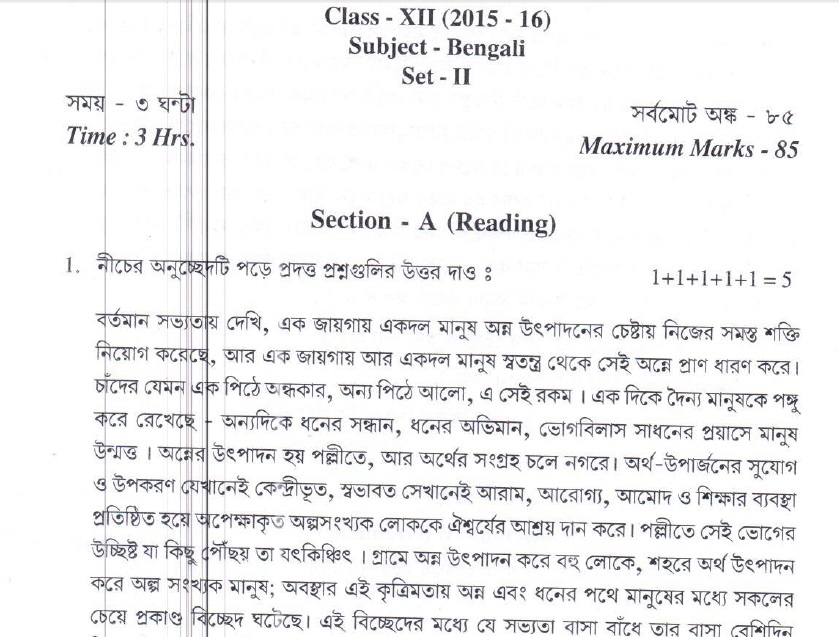
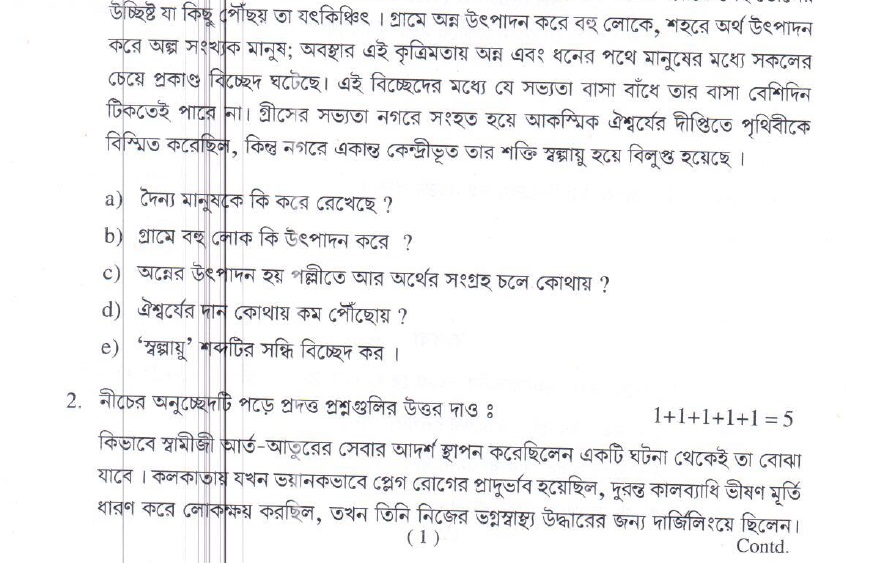
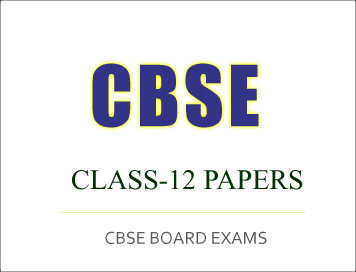
CBSE Class-12 Question Papers for IOP/Comptt Examination 2017
All India Scheme, (Hindustani Music)
CBSE Class-12 Question Papers for IOP/Cmptt Examination : Hindustani Music (Vocal)
INFORMATICS PRACTICES
Time allowed : 3 hours
Maximum Marks : 70
Instructions :
(i) Attempt any five questions.
(ii) All questions carry equal marks
1.Recognise the following Raga and write two tanas giving the complete description of that Raga :
Ga Ma Dha Ni Sȧ
2. Write the description of Raga Bhimpalasi with two alaps.
3. Why Sangeet Ratnakar has been considered an important work of Indian music in North as well as South India ? Give its complete introduction.
4. Give a detailed analysis of the three categories of Ragas with reference to the time theory of Ragas.
5. Write the definition of any three of the following :
Murki, Murchhana, Alap, Varna
6. What was the contribution of Ustad Bade Ghulam Ali Khan to Indian music, write in detail.
7. Write the theka of Dhamar tala with Dugun. Also write its detailed description.
8. Write a Drut Khyal or Dhamar with notation in any prescribed Raga of your syllabus.

CBSE Class-12 Question Papers for IOP/Comptt Examination 2017
All India Scheme, (Informatics Practices)
CBSE Class-12 Question Papers for IOP/Cmptt Examination : Informatics Practices
INFORMATICS PRACTICES
Time allowed : 3 hours
Maximum Marks : 70
General Instructions :
(i) All questions are compulsory.
(ii) Answer the questions after carefully reading the text.
1. (a) What happens to the Network with Star topology if the following happens : 2
(i) One of the computers on the network fails ?
(ii) The central hub or switch to which all computers are connected, fails ?
(b) Write the purpose of http. 2
(c) Write the purpose of the following devices : 2
Network Interface Card
Repeater
(d) How does Open source software emphasize collaboration and sharing ? 2
(e) Explain 2 measures that a school should take to ensure security of their computer network.
2. (a) Write the value that will be assigned to variable x after executing the following statement : 1
x = 3 + 36/12 + 2*5;
(b) Distinguish between parselnt() and parseDouble() methods. 1
(c) What is the difference between a PasswordField and a TextField ? 1
(d) Consider the statement : 1 fname = “Rishabh”;
(i) What is the datatype of fname ?
(ii) Is 456 the same as “456” ? Give reason.
(e) Given below is HTML code. Rewrite code after correcting errors. Underline
each correction. 2
<html>
<title>HTML
</head>
<body>
</title>
<p>Learning HTML is fun
(f) Expand XML. How are XML tags different from HTML tags ? Write two points. 2
(g) What values will be assigned to b, r and t after execution of the following code : 2
for(int i = 0; i <= 2; i++) {
switch(i) {
case 1:
{
b=i;
break;
}
case 2:
{
r=i;
break;
}
default:{
t=i; }
}
}
3. (a) What is the relationship between SQL and MySQL ? 1
(b) Define the term ‘database transaction’. 1
(c) Rashi wants to add another column ‘Hobbies’ with datatype and size as VARCHAR(50) in the already existing table ‘Student’. She has written the following statement. However it has errors. Rewrite the correct statement.
MODIFY TABLE Student Hobbies VARCHAR;
(d) Write SQL query to display employee details from table named ‘Employee’ whose ‘firstname’ ends with ‘n’ and firstname contains a total of 4 characters (including n). 1
(e) Identify Single Row functions of MySQL amongst the following : 1
TRIM(), MAX(), COUNT(*), ROUND()
(f) Write the following statement using ‘OR’ logical operator : 1
SELECT first_name, last_name, subject
FROM studentdetails
WHERE subject IN (‘Maths’, ‘Science’);
(g) Consider an “Employee” table with “Location” column. Entering data for the Location column is optional. 2
If one enters data for a row with no value for the “Location” column, what value will be saved in the “Location” column ?
Write SQL statement to display the details of rows in the “employee” table whose location is left blank.
(h) Given below is the ‘Department’ table : 2
DEPCODE DEPNAME
101 ADMIN
102 RECEPTION
103 PERSONNEL
SET AUTOCOMMIT = 0;
UPDATE Department SET DEPNAME = ‘OFFICE’ WHERE
DEPNAME = ‘ADMIN’;
INSERT INTO Department VALUES (104, ‘HRD’);
UPDATE Department SET DEPNAME = ‘FRONT OFFICE’ WHERE
DEPNAME = ‘RECEPTION’;
COMMIT;
DELETE FROM Department WHERE DEPNAME = ‘FRONT OFFICE’;
ROLLBACK;
SELECT * FROM Department;
What will be the output of the above given SELECT statement ?
4. (a) Write the values of num2 and num3 after execution of following code : 1
int num1, num2, num3;
num1 = 100;
num2 = ++num1;
num3 = num2++ + ++num1;

CBSE Class-12 Question Papers for IOP/Comptt Examination 2017
All India Scheme, (Physical Education)
CBSE Class-12 Question Papers for IOP/Cmptt Examination : Physical Education
PHYSICAL EDUCATION
Time allowed : 3 hours
Maximum Marks : 70
General Instructions :
(i) The question paper consists of 26 questions.
(ii) All questions are compulsory.
(iii) Answers to questions carrying 1 mark should be approximately 10 – 20 words.
(iv) Answers to questions carrying 3 marks should be approximately 30 – 50 words.
(v) Answers to questions carrying 5 marks should be approximately 75 – 100 words.
1.Explain the meaning of Combination Tournament.
2.What do you know “Mountaineering” an Adventurous sport ?
3.Explain the term “Eating Disorders” in brief.
4.What do you mean by correct posture ?
5.State what do you understand by Food Supplements.
6.Describe the meaning of “Amenorrhea”.
7. What do you mean by Cardiovascular Fitness ?
8. Discuss briefly about Oxygen intake and Oxygen uptake.
9. What do you understand by SPRAIN and STRAIN ?
10.Elucidate Kinetic energy.
11. Explain briefly about Motivation.
12. Deepti was cautious about her outer appearance. Though, she was not obese, but reduced weight by adapting various methods like : Fasting or less food intake, using diet pills or laxatives and excessive exercise. When her class-teacher observed her condition, she realized that extreme weight-loss can damage her physical and mental health, so, she psychologically supported her and gave suggestions to maintain healthy body-weight.
Based on the above passage, answer the following questions :
1. On the basis of symptoms, suggest the name of Eating – disorder.
2. What do you understand by healthy – body weight ?
3. What values did the class teacher reflect through her initiative ?
13.What are the advantages of keeping correct posture ? Explain.
14.What are the pitfalls of dieting ? Explain any four pitfalls of dieting.
15.Define planning. Discuss about the objectives of planning in sports.
16.Calculate and draw a fixture of Volley Ball teams on knock-out basis.
17. Write briefly about the material required and safety measures for camping.
18.Write factors, determining ‘Speed’. Explain methods for improving speed.
19. What are the Nutritive Components of Diet ? Discuss briefly.
20. What are the physical and physiological benefits of exercise for children ? Write in detail.
21. Explain AAPHER Motor fitness test, specifically mentioning various items of its test battery and its administration.
22. Elucidate about the Psychological aspects of women athletes for their limited participation in sports.
23. What do you understand by ‘ageing’ ? Explain the following :
(a) Physiological changes due to ageing.
(b) Contribution of exercise to maintain functional fitness in aged population.
24.What do you understand by body image ? Elucidate the factors influencing body image and self esteem.
25. How will you define sports medicine ? Write in detail about the aim and scope of sports medicine.
26. What is Projectile ? Explain the factors affecting projectile trajectory, with suitable examples.

CBSE Class-12 Question Papers for IOP/Comptt Examination 2017
All India Scheme, (Computer Science)
CBSE Class-12 Question Papers for IOP/Cmptt Examination : Computer Science
COMPUTER SCIENCE
Time allowed : 3 hours
Maximum Marks : 70
SECTION – A
(Only for Candidates, who opted for C++)
1. (a) Write the type of C++ tokens (keywords and user defined identifiers) from the following : 2
(i) case
(ii) _delete
(iii) WHILE
(iv) 21stName
(b) Jayneel has just started learning C++. He typed the following C++ code and during
the compilation of the code, he got some errors. When Jayneel asked his teacher,
the teacher told him to include necessary header files in the code. 1
Write the names of those header files, which Jayneel needs to include, for
successful compilation and execution of the following code.
void main()
{
cout <<"We win !"<<endl;
cout <<strlen("The World")<<endl ;
}
(c) Rewrite the following C++ code after removing any/all syntactical errors with each
correction underlined. 2
Note : Assume all header files required in the code are already being included.
#define 10*Number MAX(Number)
void main()
{
int Num,NewNum;
cout<<"Number:";
cin<<Num;
if Num<10
NewNum=MAX(Num);
else
NewNum=Num-2;
cout<<"New Number:"<<NewNum<<end;
}
(d) Find and write the output of the following C++ program code : 2
Note : Assume all required header files are already included in the program.
void Decider(int &K,int L=70)
{
if (K>L)
K-=L;
else
K+=L;
}
void main()
{
int M=100,N=40;
Decider(M,N);
cout<<M<<"#"<<N<<endl;
Decider(M);
cout<<N<<"#"<<M<<endl;
}
(e) Find and write the output of the following C++ program code : 3
Note : Assume all required header files are already being included in the program.
void DispScore(int S[],int N)
{
for(int Count = 0;Count<N;Count++)
cout<<S[Count]<<"#";
cout<<endl;
}
void main()
{
int *Point,Score[]={10,5,20,15};
Point=Score;
DispScore(Score,2);
for(int Count=0; Count<4; Count++)
{

CBSE Class-10 Marking Scheme for IOP/Comptt Examination 2017 :
English (Language and Literature)
CBSE Class-10 Marking Scheme for IOP/Comptt Examination 2017 : English (Language and Literature) (Delhi Region)
SUMMATIVE ASSESSMENT - II
Marking Scheme - English (Language and Literature)
General Instructions
1. The Marking Scheme provides general guidelines to reduce subjectivity in the marking. The answers given in the Marking Scheme are the suggested answers. The content is thus indicative. If the student has given any other answer, which is different from the one given in the Marking Scheme, but conveys the correct meaning, such answer should be given full weightage.
2. Evaluation is to be done as per the instructions provided in the Marking Scheme. It should not be done according to one's own interpretation or any other consideration. Marking Scheme should be strictly adhered to and religiously followed.
3. If the question has parts, please award marks in the right hand side for each part. Marks awarded to the different parts of the question should then be totalled up and written in the left hand margin and circled.
4. If the question does not have any parts, marks will be awarded in the lefthand margin.
5. If the candidate has attempted any extra question or part, marks obtained in the best question/part should be retained and the other answer should be scored out.
6. In the Marking Scheme, a slash (/) indicates alternative answers; any one such answer is counted as correct.
7. Brackets ( ) indicate optional information; the mark will be awarded whether the part in brackets is included or not.
8. Candidates should not be penalized if they do not follow the order of the section / question while answering.
9. In questions requiring word limit, no marks are to be deducted for exceeding the word limit.
10. Q.1 , Q.2 and Q.8 are meant to test the comprehension of the candidates and not the ability of expression. Full credit should be given for the correct value point, even if the answer is not given in a full sentence.
11. In questions consisting of 2 or more than 2 marks, break-up of marks should be shown separately (as suggested in the Marking Scheme) and then totalled.
12. A full scale of marks 0 to 100 has to be used. Please do not hesitate to award full marks if the answer deserves it.
MARKING SCHEME
CLASS X (CODE NO 184)
SUMMATIVE ASSESSMENT - II
(LANGUAGE & LITERATURE)
Section A – (Reading) 20 Marks.
Q1 Objective: To identify the main points from the text. 8 Marks
Marking: 8 marks (1 mark for each correct answer)
No penalty for spelling, punctuation or grammar mistakes. Full sentences are not required.
Answers
(a) practicing law in the city of Johannesburg in South Africa/doing law/ practicing law/ law(any one)
(b) get him a book from the office/ get him a book/ get a book/ get book / book (any one)
(c) to get him (Mr. Polak) his book as promised/ deliver the book to Mr. Polak/ give Mr. Polak his book / give him the book (any one)
(d) upset due to Bapu’s decision / punishment was very severe (any one)
(e) as this was the decision of Bapu ji / did not have the courage / no one could change Bapu’s mind (any one)
(f) Kalyan Bhai offered to get the book himself / he also offered to accompany Manilal to get the book (any one)
(g) Gandhiji earlier declined/refused permission but later agreed or allowed / Gandhiji first said ‘no’ and later ‘agreed’ (any one)
(h) kind and gentle but firm/ a man of firm decisions / believed in keeping promises (any one)
Q.2 Marking:
Qs (a) to (d) carry 2 marks each and from (e) to (h) carry 1 mark each 8 + 4 = 12 Marks
(a) (i) Problem faced by elephants - want to feed on crops but often get hit by the electric fencing around farms
(ii) Problem faced by farmers - suffer huge crop damage due to elephants(1+1)
(b)(i) To protect important tree species, crops from being damaged by elephants
(ii) Real or dummy beehives are interlinked together and if disturbed, bees come out to sting the crop raiding elephants (1+1)
(c) (i) Elephants would run from the sound of disturbed African bees
(ii) Elephants fear being stung around the sensitive parts of their body, like the eyes, inside the mouth, and up the trunk (1+1)
(d) (i) Pre-recorded bee sounds were broadcast during crop-raiding events
(ii) Showed an instant withdrawal of elephants from the crop fields (1+1)
(e) (iii) conflict (1)
(f) (i) interlinked (1)
(g) (i) stung (1)
(h) (i) generate (1)
SECTION B – (Writing & Grammar) 25 Marks
Q.3. Letter/Article Writing 5 Marks
LETTER
Objective: To use an appropriate style and format to write a formal/an informal letter.
Format 1 mark
(i) Sender’s address
(ii) Date
(iii) Receiver’s address
(iv) Subject/ Heading
(v) Salutation
(vi) Complimentary close
Content 2 marks
Expression 2 marks
{Coherence and relevance of ideas and style 1 mark}
{Grammatical accuracy, appropriate words and spellings 1 mark}]
Note: No marks are to be awarded if only the format is given. Under content credit should be given for the candidate’s creativity in presenting ideas. However, some of the following suggestive points may be included:
Value Points:
Reasons: discrimination between boys and girls in the society- dowry systemnarrow
minded people- lack of education
Prevention: think of other girls as sisters or daughters – provide them with
good education- respect them- motivate them to move forward- provide safety
for them – make parents treat girls and boys equally
OR
ARTICLE
Format (Title and writer’s name) 1 mark
Content 2 marks
Expression 2 marks
{Coherence and relevance of ideas and style 1 mark}
{Grammatical accuracy, appropriate words and spellings 1 mark}
(Value points are suggested in the Question Paper itself)
Under content credit should be given for the candidate’s creativity in presenting
ideas. However some of the following suggestive points may be included:
Value Points:
Painful to see the living condition – lack of awareness among people, hospitals swing with patients, no house left without sufferer, breeding of mosquitoes in stagnant water Mosquitoes- cause of dengue, government and non- government agencies get
involved in spreading awareness through lectures/ workshops/ advertisements, prevention better than cure – keep surroundings clean – use mosquito nets – DDT spray – wear full sleeves – cover body parts
Q.4. Story Writing 10 Marks
Objective: To plan, organize and present ideas coherently in a story
using the child’s imagination and creativity based on the given inputs.
Content : 6 marks
Fluency : 2 marks
Accuracy : 2 marks
(The beginning of the story is given in the question paper itself.)
Under content credit should be given for the candidate’s creativity in presenting ideas.
Q.5 Objective: To use grammatical items accurately and appropriately.
Marking: 1 mark for each correct answer 1 x 3 = 3 Marks
(a) (iii) made
(b) (i) small
(c) (iii) in
Q.6 Objective: To use grammatical items accurately and appropriately.
Marking: 1 mark for each correct answer 1 x 4 = 4 Marks
Error Correction
(a) in to
(b) or and
(c) breed breeding
(d) leave left
Courtesy: CBSE

CBSE Class-10 Marking Scheme for IOP/Comptt Examination 2017 :
English Communicative
CBSE Class-10 Marking Scheme for IOP/Comptt Examination 2017 : English Communicative (Delhi Region)
Social Science (Summative Assessment 2)Marking Scheme - English Communicative (Delhi - 1/1/1, 1/1/2, 1/1/3)
General Instructions:
Please note that the questions are numbered in continuation from 1 to 11.
(i) Marking of the entire script should be done by one examiner. All answers in all the scripts issued to the examiner should be marked section wise.
(ii) In the marking scheme, a slash (/) indicates alternative answers; any one such answer is counted as correct.
(iii) Brackets ( ) indicate optional information; the mark is awarded whether the part in brackets is included or not.
(iv) If a student writes an answer which is not given in the marking scheme but which is equally acceptable, full marks should be awarded.
(v) Students should not be penalized if they do not follow the order of the sections / questions while answering.
(vi) In questions requiring word limit please note that no marks are to be deducted for exceeding the word limit.
(vii) The Marking Scheme carries only suggested value points for the answers. These are only guidelines and do not constitute the complete answers. The students can have their own expression and if the expression is correct, marks should be awarded accordingly.
QUESTION PAPER CODE 1/1/1
SECTION A (READING) 20 MARKS
Note : Section A tests a candidate’s ability to read and understand only, therefore, no deductions are to be made for errors in spelling, grammar or punctuation. Marks should be awarded if the answer can be clearly understood.
Objective: This section evaluates the reading and comprehension skills of the students and their ability to infer and evaluate the given information.
1. 1. DEMOCRACY - MARKS–8
Objective : To identify the main points of a text
Marking : 8 marks – 1 mark for each correct answer
Answers :
a) in its people
b) guardian of the nation / ready to serve the people of the country
c) “Ask not what your country can do for you, ask what you can do for your country”
d) when people: (i) get the leaders they deserve (ii) play an active role in creating new type of leadership (any one)
e) by educating the youth of the country / by teaching children the importance of obeying laws
f) when given a chance to express their talents and skills / when we encourage in them new ideas and creativity
g) start a small business/ write an article/ teach a child / shop at local stores / not pollute your environment / participate in cleanliness drive / create a work of art / volunteer for a social cause or another similar effort
h) teachers and employers
2. PLASTIC WASTE TOTAL MARKS-12
Objective : To identify the main points of a text
Marking : 8 marks - 2 marks for each correct answer
2.1 Answers :
a) Millions of tons of waste from plastic bags, bottles and clothes in the oceans of the world present a serious threat to human health and marine environment
b) Chemicals in plastic and those which attach themselves to plastic in natural environment could cause poisoning and many disorders in marine life if consumed in huge quantities
c) Plastic micro particles suspended in the air can harm the lungs
d) To avoid using products with micro beads and arrange appropriate disposal of plastic products by way of recycling, if possible
2.2 Vocabulary
Marking : 4 marks - 1 mark for each correct answer
Answers :
e) (i) serious
f) (ii) large
g) (iii) very small
h) (i) negatively

CBSE Class-10 Marking Scheme for IOP/Comptt Examination 2017 :
Social Science
CBSE Class-10 Marking Scheme for IOP/Comptt Examination 2017 : Social Science (Delhi Region)
Social Science (Summative Assessment 2)
Marking Scheme ( Delhi) 32/1/1, 32/1/2, 32/1/3
|
Q.NO.
|
EXPECTED ANSWERS/ VALUE POINTS
|
Page No.
|
MARKS
|
|
1
|
Artist Frederic Sorrieu belonged to France: OR
Ngo Dinh Diem belonged to Vietnam
|
H-3
H-44
|
1
|
|
2
|
Energy is required for all the activities. It is needed : to cook /to provide light and heat / to drive vehicles / to run the machinery in industries .
Any one point .
|
G-58
|
1
|
|
3
|
Political Parties in India are recognized by :
Election Commission
|
D.P.-75
|
1
|
|
4
|
The challenge faced is :
Foundational Challenge
|
D.P.-
|
1
|
|
5
|
Pressure Groups employ Lobbyists :
To advertise their plan
|
D.P.-67
|
1
|
|
6
|
Logo of Quality is :
ISI
|
E-85
|
1
|
|
7
|
Basic Function of Foreign Trade is to connect the market of different countries .
|
E-61
|
1
|
|
8
|
Absence of Collateral is one of the major reasons which prevent the poor from getting bank loans.
|
E-50
|
1
|
|
Ideas of National unity in early 19th century Europe allied to the ideology of Liberalism :
Liberalism stood for freedom for the individual and equality of all before the law. Politically it emphasized the concept of government by consent .Since the French Revolution , Liberalism had stood for the end of autocracy and clerical privileges , a constitution and representative government through parliament .Nineteenth century liberals also stressed the inviolability of private property .
(To be assessed as a whole)
OR
U.S entry into the Vietnam war proved costly to the Vietnamese as well as the Americans :
Both the sides faced high casualties, many died and wounded .Compulsory recruitment of the people in the armed services .Minorities and working class families suffered. Thousands of US troops arrived equipped with heavy weapons and tanks and backed by the most powerful bombers of the time
.Many became disillusioned with what the US was doing and writers such as Mary McCarthy and actors like Jane Fonda even visited North Vietnam and praised their heroic defense of the country. The widespread questioning of government policy strengthened moves to negotiate an end to the war.
(To be assessed as a whole)
|
H-9
H-45,46
|
3
|
|
10
|
Reasons to launching Civil Disobedience Movement:
1. Economic depression of 1930 .
2. Arrival of Simon Commission without any Indian representative
3. Vague offer of Dominion status by the British , failed to satisfy Indians .
4. Decisions taken in Lahore session of the Congress in 1929.
5. Tax on salt by Britishers.
Any three points to be explained. Any other relevant point.
|
H-62
|
3x1 = 3
|
|
11
|
Contribution of Gandhiji towards Satyagraha :
The idea of satyagraha emphasized the power of truth and the need to search for truth . It suggested that if the cause was true , if the struggle was against injustice , then physical force was not necessary to fight the oppressor.
|
|
|
|
|
|
battle through non violence. This could be done by appealing to the consciousness of the oppressor .People including the oppressors had to be persuaded to see the truth , instead of being forced to accept truth through the use of violence . By this struggle truth was bound to ultimately triumph . Mahatma Gandhi believed that this dharma of non violence could unite all Indians. Based on the above principle Gandhiji started non cooperation movement and later civil disobedience movement .
(To be assessed as a whole)
|
H-55
|
3
|
|
12
|
Three measures to minimize the environmental degradation by the industries in India :
1. Air Pollution
i. Particulate matter in the air can be reduced by fitting smoke stacks to factories .
ii. Smoke can be reduced by using oil or gas instead of coal in factories .
2. Water Pollution
i. Minimizing the use of water for processing by reusing and recycling it in two or more successive stages.
ii. Harvesting of rain water to meet water requirement .
iii. Treating hot water and effluents before releasing them in rivers and ponds .
3. Noise Pollution
i. Machinery and equipment can be used and generators should be fitted with silencers .
ii. Almost all machinery can be redesigned to increase energy efficiency and reduce noise .
iii. Noise absorbing material may be used apart from personal use of ear plugs and earphones.
(Any other relevant point.)
|
G-78
|
3x1=3
|
|
13
|
Physical and economic factors have influenced the distribution pattern of the Indian Railways Network:
1. Northern Plains : Level land , high population density and rich agricultural resources provided the development of Railways in these plains. However a large number of rivers requiring construction of bridges across their wide banks posed some obstacles .
|
|
|
|
|
|
|
2. Penninsular region and the Himalayan region : The railway tracts are laid through low hills , gaps or tunnels .The Himalayan mountainous regions are unfavourable for the construction of railway lines due to high relief , sparse population and lack of economic opportunities .
3. Desert of Rajasthan: It was difficult to lay railway lines on the sandy plain of western Rajasthan which has hindered the development of railways .
4. Swamps of Gujarat , forested tracks of Madhya Pradesh , Chattisgarh , Odisha and Jharkhand are also not suitable for the development of railways.
5. The contiguous stretch of sahyadri could be crossed only through gaps or passes. Although the development of Konkan railway along the west coast has facilitated the movement of passengers and goods in the most important economic region of India. It has also faced a number of problems such as sinking of track in some stretches and landslides.
6. Penninsular plateau rich in minerals promotes industrial development, encourage the railway tracks.
(Any three points to be explained.)
(Atleast one physical and one economical )
|
G-85
|
3
|
|
14
|
Odisha is the largest producer of manganese: Uses of manganese in India:
1. It is used in manufacturing of steel and ferro- manganese alloy.
2. These alloys are strong and are used in making giant machines .
3. It is also used in manufacturing bleaching powder .
4. It is also used in insecticides .
5. It is also used in manufacturing of paints.
6. Any other relevant point. (Any two uses to be mentioned .)
|
G-53
|
1+2=3
|
|
|
Courtesy: CBSE

CBSE Class-10 Marking Scheme for IOP/Comptt Examination 2017 :
Science
CBSE Class-10 Marking Scheme for IOP/Comptt Examination 2017 : Science (Delhi Region)
SUMMATIVE ASSESSMENT - II
July 2017
Marking Scheme – Science (Delhi) 31/1/1
Courtesy: CBSE

CBSE Class-10 Marking Scheme for IOP/Comptt Examination 2017 :
Mathematics
CBSE Class-10 Marking Scheme for IOP/Comptt Examination 2017 : Mathematics (Delhi Region)
Marking Scheme — Mathematics 30/1/1, 30/1/2, 30/1/3 [Delhi Region]
General Instructions:
1. The Marking Scheme provides general guidelines to reduce subjectivity in the marking. The answers given in the Marking Scheme are suggested answers. The content is thus indicative. If a student has given any other answer which is different from the one given in the Marking Scheme, but conveys the meaning, such answers should be given full weightage
2. Evaluation is to be done as per instructions provided in the marking scheme. It should not be done according to one’s own interpretation or any other consideration — Marking Scheme should be strictly adhered to and religiously followed.
3. Alternative methods are accepted. Proportional marks are to be awarded.
4. If a candidate has attempted an extra question, marks obtained in the question attempted first should be retained and the other answer should be scored out.
5. A full scale of marks - 0 to 90 has to be used. Please do not hesitate to award full marks if the answer deserves it.
6. Separate Marking Scheme for all the three sets has been given.
7. As per orders of the Hon’ble Supreme Court. The candidates would now be permitted to obtain photocopy of the Answer book on request on payment of the prescribed fee. All examiners/Head xaminers are once again reminded that they must ensure that evaluation is carried out strictly as per value points for each answer as given in the Marking Scheme.
Courtesy: CBSE

CBSE Class-12 Question Papers for IOP/Comptt Examination 2017
All India Scheme, (Nepali)
CBSE Class-12 Question Papers for IOP/Cmptt Examination : Nepali
NEPALI
Time allowed : 3 hours
Maximum Marks : 100

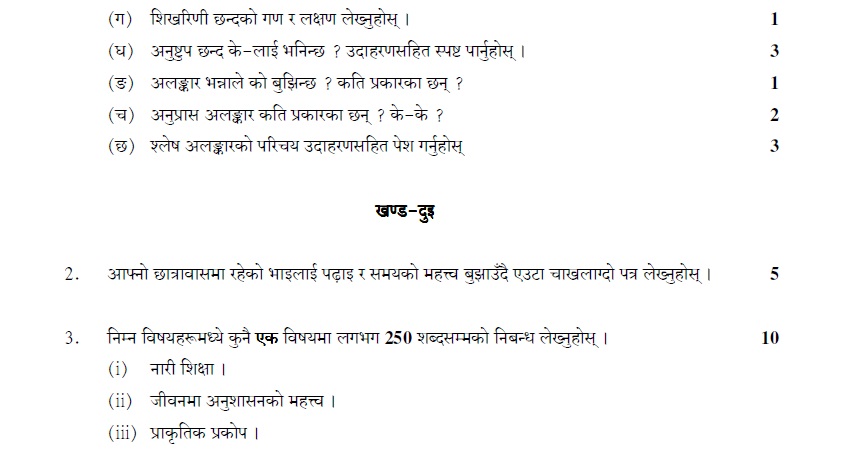
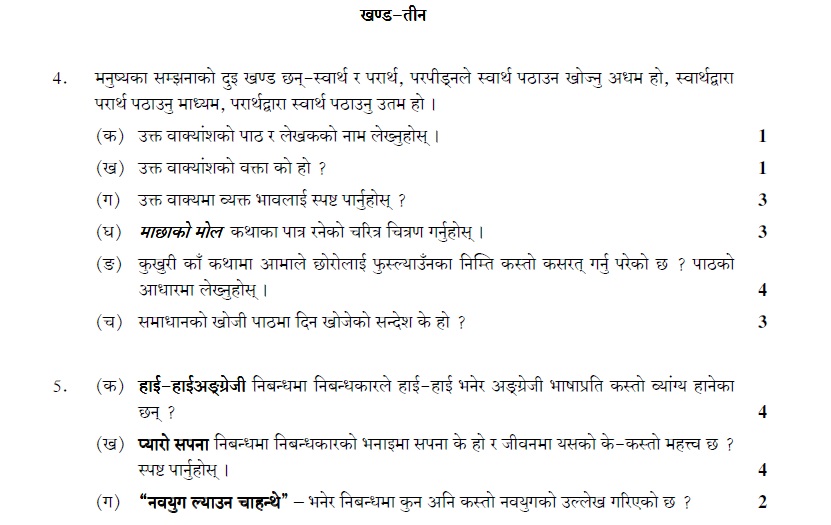
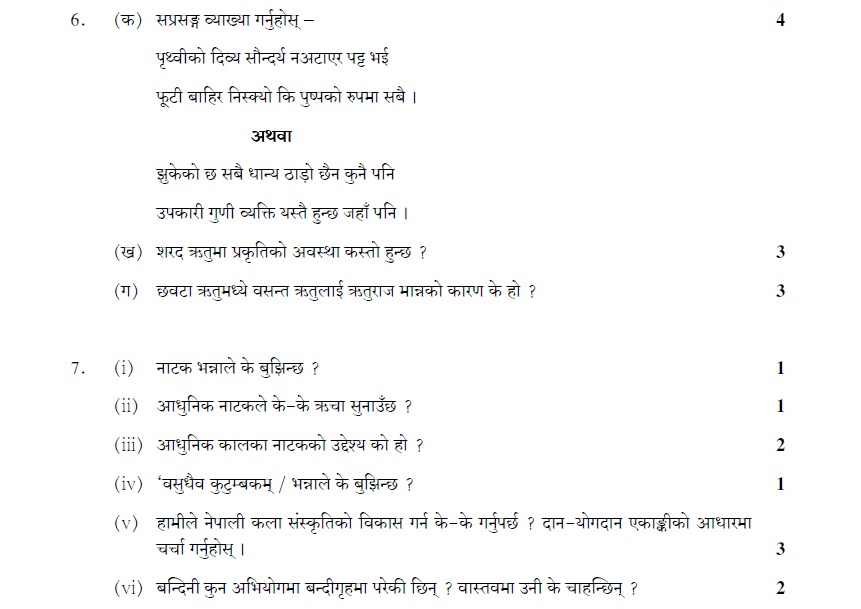

CBSE Class-12 Question Papers for IOP/Comptt Examination 2017
All India Scheme, (Japanese)
CBSE Class-12 Question Papers for IOP/Cmptt Examination : Japanese
JAPANESE
Time allowed : 3 hours
Maximum Marks : 100

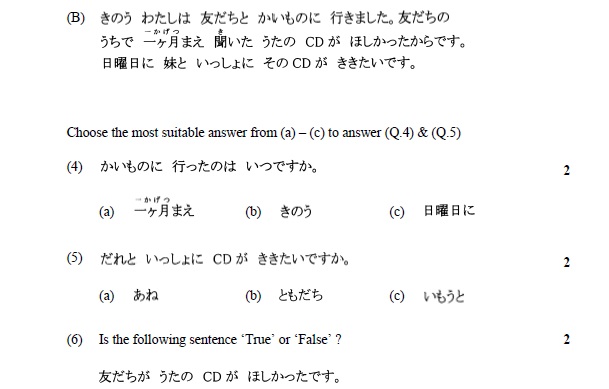
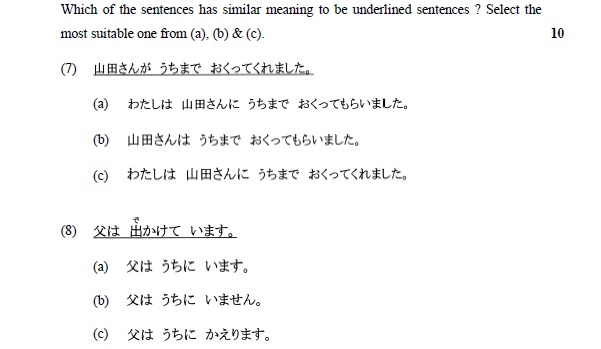
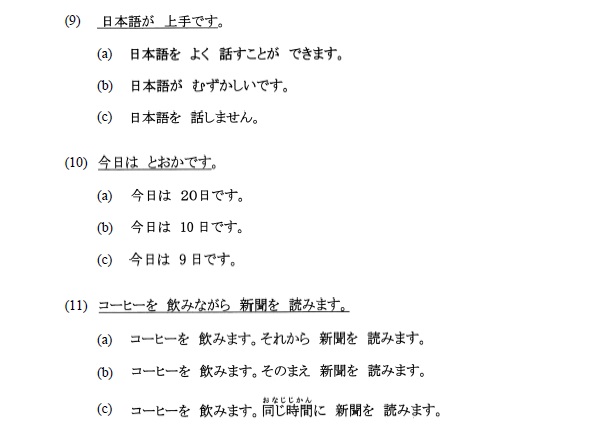

CBSE Class-12 Question Papers for IOP/Comptt Examination 2017
All India Scheme, (German)
CBSE Class-12 Question Papers for IOP/Cmptt Examination : German
German
Time allowed : 3 hours
Maximum Marks : 100
SECTION – A
I. Lies den folgenden Text und beantworte die Fragen !
Für den 21 jährigen Alex geht im Leben nichts voran, wie er sich das wünscht. Kurz vor dem Fall der Berliner Mauer f ällt seine Mutter nach einem Herzinfarkt ins Koma. Sie ist von der DDR überzeugt, und nun verschläft sie die politischen Entwicklungen
in Deutschland im Jahr 1989. Als sie nach acht Monaten wieder aufwacht, ist in ihrem Heimatland alles anders. Nach Meinung ihres Sohnes darf sie nichts vom Ende der DDR erfahren, denn er glaubt, dass ihr Herz für diese Nachricht zu schwach ist.
Deshalb lässt Alex die DDR in der Wohnung seiner Mutter weiterleben: Er spielt ihr alte Fernsehnachrichten vor, kauft typische DDR-Lebensmittel, erzählt ihr vom Leben der Leute, als hätte sich nichts geändert. Fragen :
(i) Was passierte der Mutter von Alex kurz vor dem Mauerfall ? 2
(ii) Welche bekannte politische Entwicklung fand in Deutschland 1989 statt ? 2
(iii) Wie lange war die Mutter in Koma ? 2
(iv) Warum will Alex seiner Mutter nichts vom Ende der DDR erfahren lassen ? 2
(v) Was macht Alex, damit die ehemalige DDR in der Wohnung weiterlebt ? 2
SECTION – B
II. Fasse den folgenden Text kurz auf Deutsch Zusammen ! 10
Wenn man in einer groen Stadt wohnt, ist das Leben anders. Anders als hier. Hier, in der kleinen Stadt, ist jeder Tag gleich. Ich stehe auf und bin nicht wach, esse und wei nicht, ob ich Hunger habe. Trinke und mein Mund bleibt trocken. Es ist Winter und ich schlafe noch. Jeder Tag ist gleich. In einer Stadt muss das anders sein. Ich war mal in Berlin und habe da eine Brieffreundin besucht. Wir sind sehr viel mit der U-Bahn gefahren und immer woanders ausgestiegen und immer sah es anders aus. “Riech mal”, hab ich zu ihr gesagt, “wie das hier riecht.” In der U-Bahn hat es nach Stadt gerochen, ein bisschen nach Gummi und Staub und Neon. Das war ein Geruch, den man richtig anfassen konnte. Hier riecht alles so, soo, sooo …wei nicht. Manchmal ein wenig nach Erde und nach Regen oder nach Mist. Aber wenn man das nicht riechen will, dann riecht man das auch nicht. Es ist Nachmittag. Nachmittage sind gleich. Von der Schule nach Hause kommen. Essen. Tisch abräumen, spülen. Ins Zimmer nach oben gehen, Radio an. Sitz am Schreibtisch. Mach Hausaufgaben. Geh wieder nach unten. Mach eine Kanne Tee. Schau aus dem Fenster, passiert nichts. In der Stadt wäre das anders. Da kann man einfach in der U-Bahn sitzen und sich die Leute anschauen. Da gibt es Leute, die bleiben nicht zu Hause. Man kann einfach rumlaufen, aussteigen, einsteigen, schauen.
III. In der deutschen schule in New Delhi gibt es eine Lehrstelle für eine Sekretärin. Schreibe einen Bewerbungsbrief, weil du dich für diese Stelle interessierst ! 10
Oder
Schreibe einen Brief an deinen deutschen Freund / an deine deutsche Freundin.
Schreibe ihm / ihr, wie du deine letzten Ferien verbracht hast und wo.
SECTION – C
IV. (a) Bilde Passiv 5
(i) Sie feiert ihren Geburtstag diesmal in einem Restaurant.
(ii) Die Mutter erzählte uns eine sehr schöne Geschichte.
(iii) Die Frau macht dem Gast eine Tasse Kaffee.
(iv) Die Chefin diktierte der Sekretärin einen Brief.
(v) Wen suchst du gerade ?
(b) Ergänze ! (als, wenn, dass, weil, damit) 10
(i) _______ ich in Berlin ankam, regnete es.
(ii) Sie geht in die Küche, _______ sie den Kindern was zum Essen kocht.
(iii) Woher weisst du, _______ sie nach Europa fliegt ?
(iv) Er muss die Prüfung wiederholen, _______ er sie letztesmal nicht bestanden hat.
(v) _______ du nicht bald kommst, gehe ich allein in den Park spazieren.
(c) Ergänze die Reflexivpronomen ! 5
(i) Soll ich dich kämmen ? – Nein, ich kämme _______ selbst.
(ii) Maria betrachtet _______ im Spiegel.
(iii) Wir legen _______ ins Bett. Es ist ja schon zu spät.
(iv) Warum kaufst du _______ auch keine Winterschuhe ?
(v) Zuerst wäscht er sein Auto und dann wäscht er _______ selbst.
(d) Ergänze (hättest, wäre, würden, hätten) 10
(i) Wenn du zu mir kommen kannst, _______ es besser.
(ii) Wir _______ gerne eine Weltreise machen, können aber nicht.
(iii) An meiner Stelle _______ du diese Aufgabe nie angenommen.
(iv) Ich _______ jetzt schon zu Hause, wenn ich mit dem Taxi gefahren _______.
(e) Ergänze ! (trotz, wegen, während) 5
(i) _______ finanzieller Schwierigkeiten hat er sein Studium abgebrochen.
(ii) _______ seiner Krankheit ist er nach Mumbai gefahren.
(iii) Wir haben uns _______ des Spaziergangs gut unterhalten.
(iv) _______ des hohen Fiebers kann er heute zur Schule nicht kommen.
(v) _______ der Reise hat er viele Fotos gemacht.
(f) Welches Wort passt ? Ordne zu ! Ein Wort passt zweimal ! 10
(trotzdem, aber, warum, deshalb, denn, obwohl, ob, wenn, wann)
(i) Weisst du, _______ er aus Deutschland zurückkommt ?
(ii) Er ist schwer krank, _______ bleibt er nicht zu Hause.
(iii) _______ sie das stadium abgebrochen hat, wissen wir nicht.
(iv) Sie möchte wissen, _______ du Hans heute gesehen hast.
(v) _______ es regnet, geht Hans zu Fu nach Hause.
(vi) Lena würde gerne kletten, _______ sie nicht zu ängstlich dafür wäre.
(vii) Wir müssen uns beeilen, _______ in einer viertel Stunde beginnt die Prüfung.
(viii) Mein Zug fährt in 20 Minuten, _______ habe ich es so eilig.
(ix) Ich möchte mit dir schon ins Kino gehen, _______ ich kann nicht.
(x) _______ er heute noch anruft, ist nicht sicher..
(g) Bilde die folgenden Sätze im Futur ! 5
(i) Nächste Woche fahre ich in die Schweiz.
(ii) Ich esse heute zu Hause eine Pizza.
(iii) Sie ist jetzt zu Hause.
(iv) Mein Vater kommt gegen 18 Uhr vom Büro.
(v) Sie erzählt uns eine Geschichte.
V. Lies den Text und beantworte die Fragen !
Die amerikanische Firma Moller International verspricht die ultimative Lösung für unsere Verkehrsprobleme. : Das “Skycar”, ein Auto, das senkrecht in die Luft startet und mit maximal 600 km/h über jeden Stau hinwegfliegt. Es ist 6 Meter lang,
2, 5 Meter breit und kann bis 9000 Meter hoch fliegen. Der Preis : 1 Million Dollar. Das futurristische Gerät wurde von Paul Moller in über 40 Jahren Arbeit entwickelt und jetzt auf der FUTURA vorgestellt. “Es ist wie auf einem fliegenden Teppich. Nur
der weite Horizont befindet sich vor dir, wenn sich das Skycar in die Luft erhebt,” sagte Paul Moller begeistert über sein High-Tech-Baby. Seit 2000 wird das Skycar für den Verkauf produziert.
Fragen :
(i) Was ist ein, Skycarʻ ? 3
(ii) Wie sieht das, Skycarʻ aus ? 2
(iii) Warum hat die Firma Moller das, Skycarʻ entwickelt ? 5
(iv) Wie funktioniert das, Skycarʻ ? 3
Wie heien die Gegenteile von : 2
(i) senkrecht
(ii) maximal
VI. Lies den folgenden Text und beantworte die nachstehende Frage :
Ich komme gut mit allen in der Klasse aus. Etwas stört mich aber manchmal: Beim Fuballspielen wird man oft in einer anderen Sprache beschimpft und hin und wieder beleidigt. Wenn wir mehr Respekt zeigen würden, hätten wir auch weniger
Konflikte.” (Tommy) Frage : Was meint Tommy, wenn er über,, Respekt zeigen“ spricht ?

CBSE Class-12 Question Papers for IOP/Comptt Examination 2017
All India Scheme, (French)
CBSE Class-12 Question Papers for IOP/Cmptt Examination : French
FRENCH
Time allowed : 3 hours
Maximum Marks : 100
SECTION – A
(Comprehension) 25 MARKS
1. (A) Lisez bien ce texte et répondez aux questions données ci-dessous :
FAMILLE FRANÇAISE : CHEZ LES LEGRAND
«Allons mes enfants, il est temps de vous lever ! » Mme Legrand, debout la première vient de réveiller Jean et Cécile; elle leur a déjà préparé leur petit déjeuner, elle a passé l’aspirateur dans toutes les pièces. …..À neuf heures elle descend avec son mari; lui, il va ouvrir son magasin de librairie. «Moi, je vais au marché, lui dit-elle; à tout à l’heure! »
En rentrant, elle met le rôti au four, épluche les légumes; il ne faut pas qu’elle se mette en retard, car tout doit être prêt à midi et demi. M. Legrand et les enfants auront juste le temps de déjeuner. Les voilà déjà qui rentrent, …… Cécile a couru à la cuisine pour embrasser sa mère….
À quoi va-t-elle occuper son après-midi ? Lundi, elle a fait des confitures: soixante pots, pleins de confitures d’oranges sont alignés dans les armoires; mardi il a fallu faire la lessive (heureusement il y a la machine à laver) ! Hier Mme Legrand a offert le thé à ses amies. Mais aujourd’hui, elle aura le temps de repasser le linge qu’elle a lavé avant-hier: il est même possible qu’elle fasse un peu de couture…..
(a) (i) Que fait Mme Legrand dès son réveil ?
(ii) Où va M. Legrand le matin ? À quelle heure ?
(iii) Que fait Mme Legrand en revenant chez elle ?
(iv) Mme Legrand achète-t-elle des pots de confitures ? Comment le savez-vous ?
(v) Que fait Cécile en rentrant ? 5 × 2 = 10
(b) Dites autrement : 2 × 1 = 2
(i) « à tout à l’heure! »
(ii) « À quoi va-t-elle occuper son après-midi ? »
(c) Complétez avec les mots du texte : 4 × ½ = 2
(i) Jennie aime boire du _________ le matin.
(ii) Elle achète des pots de _________ pour ses enfants.
(iii) Pourquoi est-elle _________ allée se coucher ?
(iv) Mme Dupont dit à sa bonne : « Mettez le _________ sale dans la machine à laver, s’il vous plaıt ! »
(d) Cherchez une phrase à la voix passive et mettez-la à la voix active. 1
(B) Lisez bien ce texte et répondez aux questions données ci-dessous :
UNE PISCINE EXCEPTIONNELLE
Une piscine qui relie deux immeubles à 40 mètres de hauteur, c’est le projet un peu fou d’une société anglaise. Ses dirigeants espèrent livrer cette piscine pas comme les autres en 2017. Le projet devrait voir le jour dans le quartier de « Nine Elms », dans la banlieue sud de Londres (Angleterre), en 2017. Ce sont les promoteurs [constructeurs d’habitations] « Ballymore Group » qui l’a lancé. Ils souhaitent construire deux immeubles de luxe, reliés entre eux non seulement par une passerelle, mais aussi par une piscine. Située à 40 mètres de hauteur, cette piscine aérienne devrait mesurer 25 mètres de long pour 5 mètres de large et 3 mètres de profondeur. Et surtout, elle possèdera des *parois de près de 25 centimètres d’épaisseur de verre.
Les constructeurs l’assurent, les technologies de construction modernes permettent ce genre de création, en toute sécurité. “Cette expérience de la natation sera vraiment unique en son genre, ce sera comme flotter dans les airs au-dessus de Londres”, promet l’un des constructeurs. Unique, mais aussi très chère. L’accès à la piscine sera réservé aux habitants des appartements, dont le premier prix est fixé à 850.000 euros. * parois : glass partitions
(a) (i) Quel est le projet de la société anglaise ? Quelle est sa date prévue ?
(ii) Que promet l’un des constructeurs ? 2 × 2 = 4
(b) Cherchez dans le texte : 8 × ½ = 4
(i) Des expressions qui veulent dire :
« Le projet devrait être prêt…. »;
« Les constructeurs sont certains qu’ils peuvent construire comme cela avec les technologies modernes….»
(ii) Le contraire de « détruire »; « au-dessous ».
(iii) La forme nominale de « créer »; « habiter ».
(iv) La forme verbale de « souhait »; « possession ».
(c) Dites “vrai” ou “faux” : 4 × ½ = 2
(i) Les constructeurs sont ambitieux.
(ii) Il y aura une passerelle entre les deux immeubles.
(iii) La piscine aura 5 mètres de profondeur.
(iv) N’importe qui pourrait nager dans la piscine.
SECTION – B
(Writing Skills) 20 MARKS
2. (a) Rédigez une histoire en utilisant les mots donnés ci-dessous (120 mots) 10
(i) des copains – aller pique-niquer – emmener pelles et seaux – s’amuser sur la plage – construire – châteaux et pâtés – nager – tout à coup – grandes vagues – ami se noyer – appeler au secours – des personnes accourir – sauver l’ami.
OU
(ii) Théodore – jeune homme imprudent – jeter cigarette mal éteinte – catastrophe – étincelles – grandes flammes – vent – incendie – plusieurs immeubles brûlés – dégâts considérables.
(b) Écrivez sur UN des sujets (120 mots) : 10
(i) Un voyage en avion. (hôtesse de l’air accueillir – pilote mettre moteurs en marche – avion rouler – piste d’envol)
(ii) Un accident d’auto. (brouillard épais – ne rien voir – voiture monter sur trottoir – se renverser)
(iii) Une lettre à vos grands-parents les remerciant pour le cadeau qu’ils vous ont envoyé.
SECTION – C
(Applied Grammar) 25 MARKS
3. (a) Trouvez les questions : 5 × 1 = 5
(i) Il fait très chaud à Chennai en été.
(ii) Madeleine a 21 ans.
(iii) Mon correspondant habite à l’île de la Réunion.
(iv) Il y a quatre livres dans son cartable.
(v) Elles viennent du Canada.
(b) Remplissez les tirets avec le temps convenable des verbes : 5 × 1 = 5
(i) Les touristes _________ le Taj Mahal la semaine prochaine. (visiter)
(ii) Je _________ plusieurs voyages en barque. (déjà faire)
(iii) Mon amie _______ une télévision dans son séjour, il y a un instant. (installer)
(iv) Si tu étais malade, tu _______ venir au concert avec nous. (ne pas pouvoir)
(v) Si les ouvriers nettoient leurs outils avant de les ranger, ils _________ de problèmes. (ne pas avoir)
(c) Corrigez ces fautes et récrivez : 5 × 1 = 5
Le Colisée est une immense et magnifique amphithéâtre située au centre de Rome. Son construction date de l’an 70 !!! 50 000 à 75 000 spectateurs venait voir les combats de gladiateurs.
(d) Mettez ces phrases au discours direct ou rapporté selon le cas : 5 × 1 = 5
(i) Mon ami me demande : « À quelle heure viendras-tu chez moi ? ».
(ii) Hélène conseille son frère : « Range ton cartable avant de te coucher ! »
(iii) La mère de Véronique lui demande ce qu’elle a acheté pour l’anniversaire de Joé.
(iv) Papa conseille à Mohan : « Arrête-toi au carrefour ! »
(v) Le professeur exige ses élèves qu’ils soient à l’heure tous les jours.
Pages

|